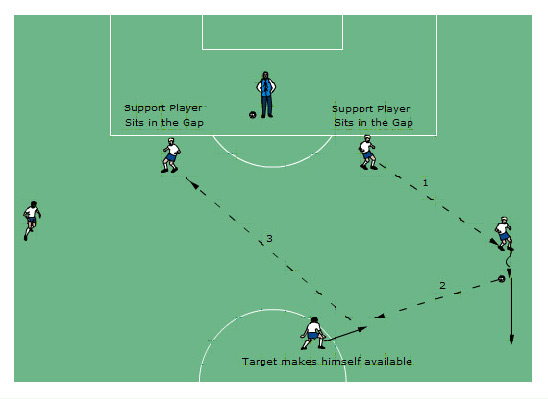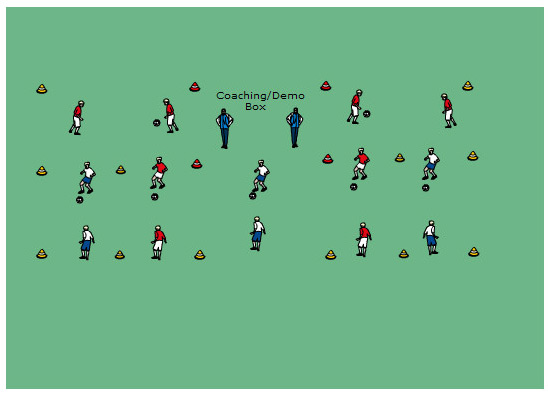 At the 2007 NSCAA Convention in Indianapolis I had the pleasure to watch Dave Brandt, now Head Coach of the US Naval Academy, run a session on Developing Technical Precision for Championship Performance in Matches. Coach Brandt had been a 6 time National Championship Winning Coach at Messiah College prior to moving to the Naval Academy. What struck me about the session was the organization and attention to detail. In over a decade of attending the NSCAA Convention, Coach Brandt’s session remains one of my favorites.
At the 2007 NSCAA Convention in Indianapolis I had the pleasure to watch Dave Brandt, now Head Coach of the US Naval Academy, run a session on Developing Technical Precision for Championship Performance in Matches. Coach Brandt had been a 6 time National Championship Winning Coach at Messiah College prior to moving to the Naval Academy. What struck me about the session was the organization and attention to detail. In over a decade of attending the NSCAA Convention, Coach Brandt’s session remains one of my favorites.
[ Teaching Technical Precision ]
Coach Brandt’s Three Themes for all Training Sessions
- Link- There must be a link from practice to the game! Can we create exercises and an environment in training that mirrors the game?
- Team Agreements- At every training session Coach Brandt runs there is a single theme that must be adhered to throughout training. For this particular practice all players must receive the ball across their body, i.e. If you receive the ball (from your left) with your right foot, you must play the ball with your right foot.
- Tools- Coach Brandt provides the players with a “tool” or a skill that will help them throughout the session. The “tool” is optional for the players to use, but most will find it a great option as the session moves forward. In this practice the coach introduced a “three touch Cruyff” as the optional tool.
Warm-up- Coach Brandt used the warm-up to provide the players maximum repetition while also setting the mentality for the entire practice. He was detail oriented and concentrated on the footwork of the players. On a number of occasions you could hear him say “I want it to be perfect”. Two themes throughout the warm-up:
- Ball Speed- pace of the pass
- Handling Speed- Time between receiving the pass and playing your pass.
The Set-up: (as pictured). Coach Brandt created a coaching box in the center of a horseshoe where he could observe all groups and use as a demonstration area. Note: I’ve taken the liberty to differentiate the groups by using colors. This isn’t necessary, but if you do choose to put them in set teams for the training session it can be a good habit to do so right from the warm-up. Exercise 1: Two touch passing. If you receive with your right foot, you MUST pass with your right foot (same with the left). Focus remained on Ball speed and Handling Speed. Coach asked for “as little wasted ball movement as possible”. 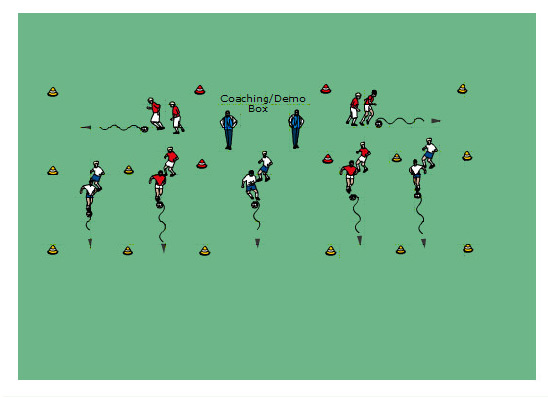 Exercise 2: Introduction of a “tool”. The three touch Cruyff. The first player now dribbles twice with the same foot, performs a Cruyff move with the same dribbling foot on his third touch, and immediately passes the ball to his teammate with his opposite foot. The players exchange places. The focus remained on the ball speed and handling speed. When the players started to get “lazy in their habits”, the exercise was stopped and players were reminded to “do the right things correctly all of the time”. This brief reminder refocused the players to the importance of focusing on the details and good habits that they’ll need to succeed as the practice moves forward.
Exercise 2: Introduction of a “tool”. The three touch Cruyff. The first player now dribbles twice with the same foot, performs a Cruyff move with the same dribbling foot on his third touch, and immediately passes the ball to his teammate with his opposite foot. The players exchange places. The focus remained on the ball speed and handling speed. When the players started to get “lazy in their habits”, the exercise was stopped and players were reminded to “do the right things correctly all of the time”. This brief reminder refocused the players to the importance of focusing on the details and good habits that they’ll need to succeed as the practice moves forward.
Dutch Diamond Passing Circuit
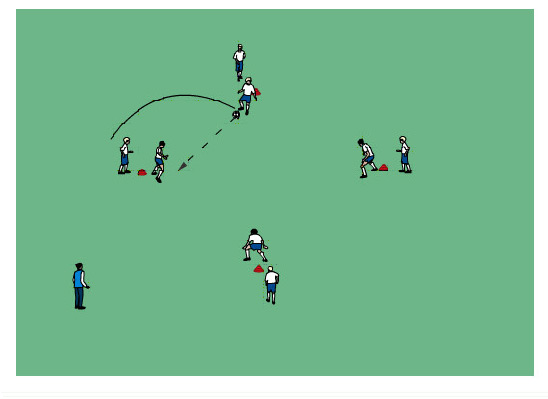 The Set-up: (as pictured) Group of 8 players, 1 ball between them positioned around a 15 x 15 Diamond. The Exercise: Introduction of the “Team Agreement”. Everything must be done in two touches (prepare it and play it). Players MUST receive the ball across their body with their right foot and pass the ball with their right foot to the next teammate. Follow your pass to the next line. Note: Receiving players should stand in front of the discs.
The Set-up: (as pictured) Group of 8 players, 1 ball between them positioned around a 15 x 15 Diamond. The Exercise: Introduction of the “Team Agreement”. Everything must be done in two touches (prepare it and play it). Players MUST receive the ball across their body with their right foot and pass the ball with their right foot to the next teammate. Follow your pass to the next line. Note: Receiving players should stand in front of the discs.
1st Progression: The Three Touch Cruyff
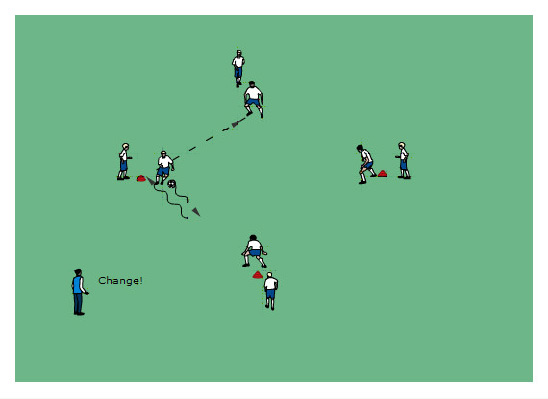 The Exercise: The initial exercise continues, but now when the coach yells Change! The next person to receive the ball performs a three touch Cruyff and reverses the direction of the circuit. However, if you are already committed to the pass, pass it and the next person should perform the Cruyff move. Note: The three touch Cruyff should be performed exactly the way it was introduced during the warm-up stages! Players still must follow their pass to the end of the next line.
The Exercise: The initial exercise continues, but now when the coach yells Change! The next person to receive the ball performs a three touch Cruyff and reverses the direction of the circuit. However, if you are already committed to the pass, pass it and the next person should perform the Cruyff move. Note: The three touch Cruyff should be performed exactly the way it was introduced during the warm-up stages! Players still must follow their pass to the end of the next line.
2nd Progression: The Split
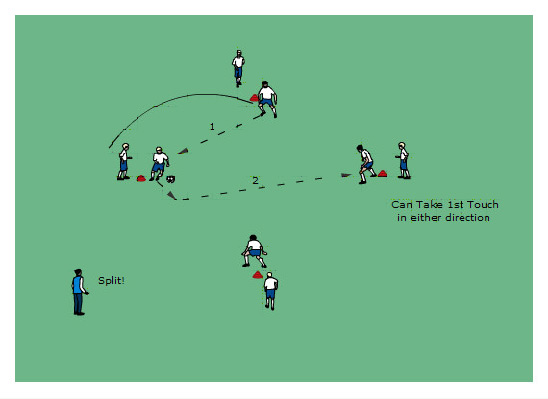 The Exercise: The initial exercise continues, but now when the coach yells Split! The next person to receive the ball prepares the ball across his body (following the team agreement), but instead of continuing the play to the next line, plays a crisp ball directly across to the opposite side. This will mirror “splitting the defense” with a pass. The receiving player can now take the ball in either direction, but must play left if they receive with their left/play right if they receive with their right. Note: Coach can still call change. This will keep the players focused mentally. Players still must follow their pass to the opposite line.
The Exercise: The initial exercise continues, but now when the coach yells Split! The next person to receive the ball prepares the ball across his body (following the team agreement), but instead of continuing the play to the next line, plays a crisp ball directly across to the opposite side. This will mirror “splitting the defense” with a pass. The receiving player can now take the ball in either direction, but must play left if they receive with their left/play right if they receive with their right. Note: Coach can still call change. This will keep the players focused mentally. Players still must follow their pass to the opposite line.
3rd Progression: Backside
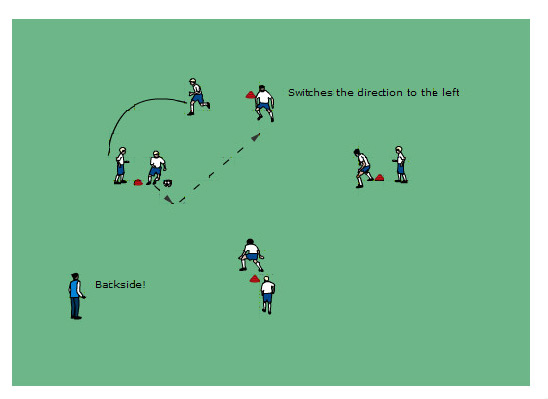 The Exercise: The initial exercise continues, but now when the coach yells Backside! The next person to receive the ball prepares the ball across his body (following the team agreement), but instead of continuing the play to the next line, clips the ball directly back to the line he just received it from. This pass is often done when a team is pressing and over pursues the play. It is a difficult skill to acquire and a dangerous pass to make unless done accurately. Note: Coach can still call change or split. This will continue to increase the players’ mental focus. Players still must follow their pass to the end of the next line.
The Exercise: The initial exercise continues, but now when the coach yells Backside! The next person to receive the ball prepares the ball across his body (following the team agreement), but instead of continuing the play to the next line, clips the ball directly back to the line he just received it from. This pass is often done when a team is pressing and over pursues the play. It is a difficult skill to acquire and a dangerous pass to make unless done accurately. Note: Coach can still call change or split. This will continue to increase the players’ mental focus. Players still must follow their pass to the end of the next line.
Final Progression: Players’ Decide
The Exercise: Now that all the various concepts have been introduced the coach allows the players to determine which movement to carry out. The only rule that remains is the “team agreement”. Coach should continue to observe the ball speed and handling speed. Another area that should begin to surface is greater communication from the players. They now have ownership of their activity. Do they set a high standard for themselves both technically and mentally? Do they demand the precision from one another that the session is aiming for?
5 vs. 0 Position Play
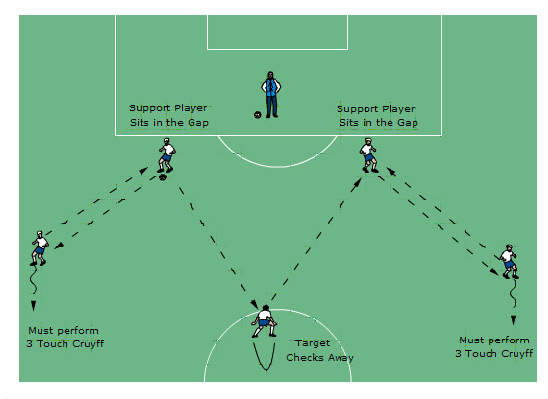 The Set-up: 5 players now take up positions on the field which give the team width (wing players), depth (target player), and support (backs). We are now looking for both technical precision, but also positional precision. Coach Brandt asked the backs (supporting players) to take up positions that will create a triangle between themselves, the target player and the wing on their side. The Exercise: The ball gets circulated in a W pattern as pictured. The team agreement of receiving the ball & playing the ball remains a constant. All players are two touches with the wing players given a third touch to perform a 3 touch Cruyff. Wing players must check away before receiving the ball. They should time their run so you receive the ball at the original starting point. All players must call for the ball in one of two ways, Yes! or by calling the name of the passer. Tools or Options:
The Set-up: 5 players now take up positions on the field which give the team width (wing players), depth (target player), and support (backs). We are now looking for both technical precision, but also positional precision. Coach Brandt asked the backs (supporting players) to take up positions that will create a triangle between themselves, the target player and the wing on their side. The Exercise: The ball gets circulated in a W pattern as pictured. The team agreement of receiving the ball & playing the ball remains a constant. All players are two touches with the wing players given a third touch to perform a 3 touch Cruyff. Wing players must check away before receiving the ball. They should time their run so you receive the ball at the original starting point. All players must call for the ball in one of two ways, Yes! or by calling the name of the passer. Tools or Options:
- The supporting players can now perform a “3 touch Cruyff” and change the direction without playing wide.
- The winger can now play one touch back to the support player and Go! Hard run forward down the wing.
- (pictured below) Changing the point of attack through the target player. The winger can now receive the ball and play into the target. The winger should continue to run forward to draw the attention of the defense. The target player should open up with the ball and play the support player on the weak side.
- Allow the supporting players to play “backside” to the opposite winger (from the Dutch Diamond circuit).
K+5 vs. 3
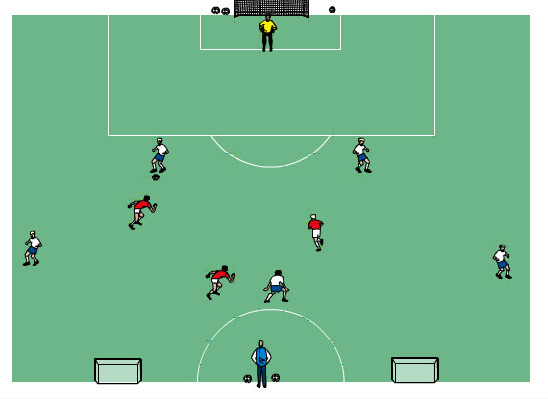 The Game: 5 white players attack two small goals while defending a full sized goal. The white team cannot play through their keeper. The team of 5 has a two touch restriction, but is allowed a 3rd touch to perform the Cruyff move. The group of 3 is without restriction. Rule: The winger and supporting player can only score in the goal on their side of the field. This should promote quick ball circulation and help the group of 5 keep their spacing. Coach should observe:
The Game: 5 white players attack two small goals while defending a full sized goal. The white team cannot play through their keeper. The team of 5 has a two touch restriction, but is allowed a 3rd touch to perform the Cruyff move. The group of 3 is without restriction. Rule: The winger and supporting player can only score in the goal on their side of the field. This should promote quick ball circulation and help the group of 5 keep their spacing. Coach should observe:
- Ball Speed- Speed of the Pass
- Handling Speed
- Are the tools they’ve been given being utilized?
- Decision Making
Progress to: K+ 5 vs. 4
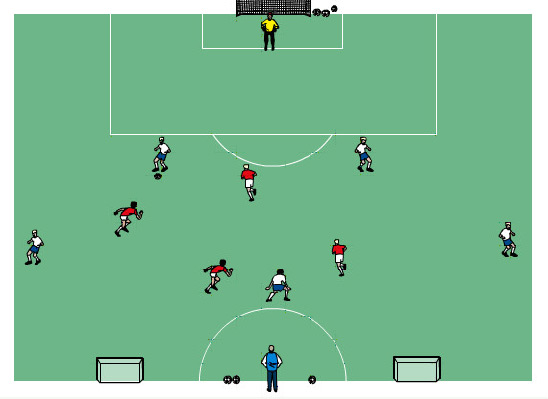 The Game: Same as above, but now the pressure has been increased. Rule Change: White can now play back through their keeper. Final Thought: Preparing a team is a daily process. Coach Brandt shared a term that spoke to this point. “Don’t chase Butterflies”. A butterfly is all over the map and is a hit or miss proposition. Having a consistent approach to training is important. Create a link from training to the game, establish team agreements and give your players the tools to excel. If these three themes are a constant in all our training sessions, the technical precision of the individual players and the collective group will foster a high level performance environment on a daily basis. This environment is the foundation for Championship Performance in Matches. [ print/download this exercise ]
The Game: Same as above, but now the pressure has been increased. Rule Change: White can now play back through their keeper. Final Thought: Preparing a team is a daily process. Coach Brandt shared a term that spoke to this point. “Don’t chase Butterflies”. A butterfly is all over the map and is a hit or miss proposition. Having a consistent approach to training is important. Create a link from training to the game, establish team agreements and give your players the tools to excel. If these three themes are a constant in all our training sessions, the technical precision of the individual players and the collective group will foster a high level performance environment on a daily basis. This environment is the foundation for Championship Performance in Matches. [ print/download this exercise ]
